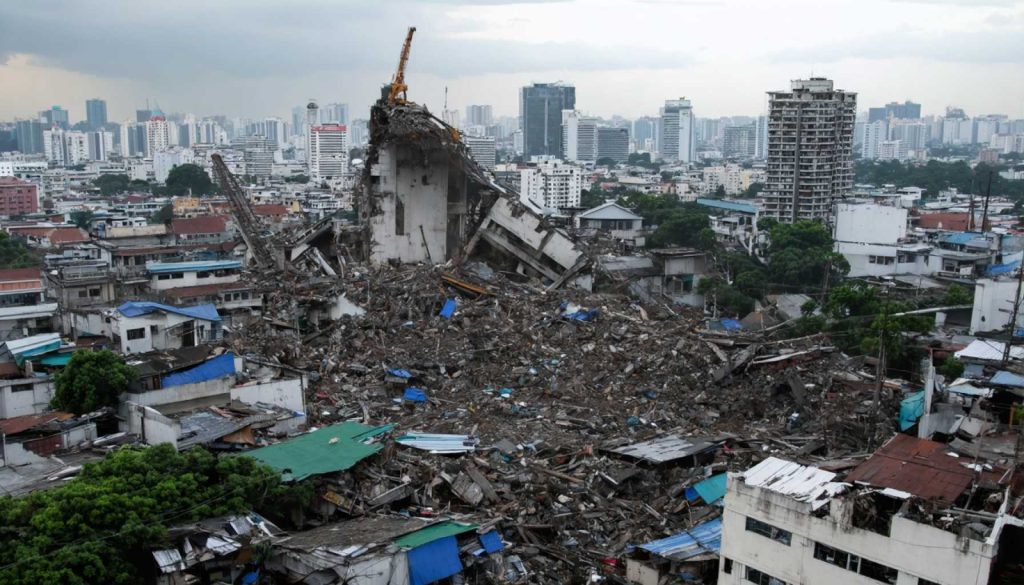
- An earthquake of magnitude 7.5 struck Southeast Asia, with its epicenter in northern Myanmar, impacting regions like Bangkok.
- Bangkok was declared a level 2 disaster zone due to structural damage and safety concerns, showcasing nature’s powerful impact.
- Emergency response teams quickly mobilized to assess damage and ensure safety, demonstrating preparedness and resilience.
- The community’s solidarity shone through, with shelters and grassroots efforts providing aid and support to affected residents.
- This incident emphasizes the importance of preparedness and unity in facing natural disasters, highlighting Bangkok’s proactive stance.
A thunderous rumble cascaded through Southeast Asia early Friday, as a magnitude 7.5 earthquake rocked the region. In an instant, the bustling streets of Bangkok were transformed into scenes of alarm and prompt action. The epicenter, nestled deep within northern Myanmar, unleashed formidable forces that reverberated through neighboring landscapes, casting long, wavering shadows over Thailand’s vibrant capital.
Bangkok, a city defined by its resilience and rhythm, was soon thrust into a heightened state of emergency. With debris from damaged buildings scattering the skyline, the Bangkok Metropolitan Administration swiftly declared it a level 2 disaster zone—a stark reminder of nature’s unyielding power. This rare and potent tremor threatened the foundations of the city’s infrastructure and its spirit.
Urban towers, symbols of human endeavor, now appeared vulnerable. Office complexes and residential buildings were scrutinized for structural integrity, their occupants evacuated to ensure safety. The city’s emergency teams, equipped with expertise and determination, navigated the labyrinthine streets, assessing damage while ensuring the welfare of shaken residents.
In the wake of upheaval, the community came together, revealing the collective strength and solidarity of Bangkok’s diverse populace. From hastily organized shelters providing refuge to inventive grassroots efforts delivering aid, every individual contribution illustrated a profound communal bond that glows brightest in times of adversity.
While aftershocks rippled through both earth and emotion, the immediate response highlighted the Bangkok administration’s preparedness—a proactive stance fortified by prior drills and robust safety infrastructures. The city’s rapid mobilization of resources, alongside the people’s indomitable spirit, served as a beacon of hope amidst the uncertainty.
Ensure that Bangkok stands resilient in the face of nature’s trials, our shared takeaway is resoundingly clear: preparedness and unity are paramount. As the city weathers this seismic test, the collective heartbeat of its community echoes louder, undeterred by the shifting ground beneath their feet.
When the Earth Shakes: Lessons From Bangkok’s Earthquake Response
A Closer Look at Bangkok’s Earthquake Resilience
In the immediate aftermath of the magnitude 7.5 earthquake centered in northern Myanmar, Bangkok faced unprecedented challenges. Here’s a closer look at additional facts not fully explored in the initial report, alongside real-world insights and recommendations.
Understanding Earthquakes: FAQs and Facts
1. What causes an earthquake of this magnitude?
Earthquakes occur due to the sudden release of energy in the Earth’s crust, usually caused by tectonic plate movements. The magnitude 7.5 quake indicates a significant release of energy, often resulting from a fault slip or collision between plates.
2. How are cities like Bangkok affected despite being far from the epicenter?
Even though Bangkok is located hundreds of kilometers from the epicenter, the seismic waves traveled through the earth’s surface, affecting the city’s infrastructure due to its susceptibility to earthquake vibrations, especially in tall buildings erected on soft soil.
Safety and Preparedness: Life Hacks and Tips
– Ensure Structural Safety: Regular inspection and retrofitting of buildings can significantly enhance their resilience to earthquakes. It’s crucial to employ expert structural engineers for assessments.
– Have an Emergency Kit Ready: Prepare an emergency kit including water, non-perishable foods, flashlights, batteries, medical supplies, and important documents.
– Plan and Practice Drills: Conducting regular evacuation drills in homes and workplaces can enhance preparedness and ensure everyone knows how to react promptly during an earthquake.
Market Forecasts & Industry Trends
The construction industry in Southeast Asia is expected to prioritize seismic retrofitting and earthquake-resilient technologies as awareness about earthquake risks grows. Innovation in building materials, such as shock-absorbing foundations and flexible structures, will likely see increased adoption.
Emerging Controversies & Limitations
While Bangkok’s immediate response was commendable, there are ongoing debates about the sufficiency of regulations governing building codes specifically in relation to seismic safety. Critics argue that more stringent standards are required to ensure future constructions can withstand similar events.
Reviews & Comparisons: Seismic Safety Protocols
Bangkok’s response can be compared with other earthquake-prone regions like Japan, where advanced technology and early warning systems are extensively used. Tapping into global best practices could enhance Bangkok’s preparedness further.
Recommendations and Quick Tips
1. Strengthen Building Codes: Implement more rigorous standards that address potential seismic activities to enhance safety and structural integrity.
2. Implement Advanced Alert Systems: Invest in technology that provides early earthquake warnings, giving residents valuable seconds to seek safety.
3. Community Engagement: Educate the public on earthquake preparedness and survival tactics through workshops and community programs.
4. Government Collaboration: Foster cooperation between governmental and non-governmental organizations for effective disaster response planning.
Conclusion
Though Bangkok faced significant difficulties, its response exemplifies the vital roles of preparedness and community strength in mitigating earthquake impacts. By learning from this event and adopting proactive strategies, cities worldwide can better equip themselves to handle such unforeseen natural calamities.
For further information on enhancing urban resilience, visit [Resilience Strategies](https://resilience.org).



